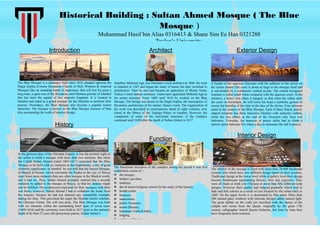
Information Literacy
- 1. Introduction The Blue Mosque is a sanctuary built since 1616 situated opposite the Hagia Sophia (Former Byzantine Church of Holy Wisdom & Imperial Mosque) like an unending battle of supremacy that will last for quite a long time, a quiet war of the Byzantine and Ottoman periods of Istanbul that has been the capital of two majestic kingdom. It is located in Istanbul and stand as a grand mosque for the Muslims to perform their prayers. Nowadays, the Blue Mosque also become a popular tourist attraction. The mosque is known as the Blue Mosque because of blue tiles surrounding the walls of interior design. History In the glorious days of the Ottoman Empire, it was the premier right of the sultan to build a mosque with more than two minarets. But when the Caliph Sultan Ahmed (ruled 1603-1617) requested that the Blue Mosque to be built with six minarets in the hippodrome, a site of great symbolic significance in Istanbul, he was told that the Sacred Mosque, al-Masjid al-Haram, which surrounds the Kaaba in the city of Mecca must boast more minarets than any other mosque in the Muslim world, and it had six. Thus, Sultan Ahmed promptly ordered that a seventh minarets be added to the mosque in Mecca, so that his fantasy might can be fulfilled. His predecessors had paid for their mosques with their war booty, however, Sultan Ahmed I had to withdraw the funds from the treasury, because he had not attained any remarkable triumphs during his time. This provoked the anger the Muslim lawful scholars, the Ottoman Ulema. His will was done. The Blue Mosque was built with six minarets within the outstanding brief span of seven years (1609-1616) and the ceremony were held in 1617 prior to the untimely death of its then 27-year old eponymous patron, Sultan Ahmet I. Architect Sedefkar Mehmed Aga was Ottoman’s royal architect in 1606. He went to Istanbul in 1567 and began the study of music but later switched to architecture. Then he met and became an apprentice of Mimar Sinan, Turkey’s most famous architect, whom later appointed Mehmed Aga as his senior assistant. From 1609 until 1616 he worked on the Blue Mosque. The design was based on the Hagia Sophia, the masterpiece of Byzantine architecture of his master, Sinan’s work. The organization of his work was described in conscientious detail in eight volumes, now found in the library of the Topkapı Palace in Istanbul. However, the completion of some of the functional structures of the complex continued until 1620 after the death of Sultan Ahmet in 1617. Function The functional structures of the complex during the period it was first established consist of :- the mosque, Sultan’s pavilion, madrasa, dar-ül kurra (religious school for the study of the Quran), health center, hospices, mausoleum, public fountains, arasta (Bazaar), hammam (Turkish bath), lodging, cellars and houses. Historical Building : Sultan Ahmed Mosque ( The Blue Mosque ) Muhammad Hasif bin Alias 0316413 & Shane Sim Ee Han 0321288 Taylor’s University Interior Design The interior of the mosque is lined with more than 20,000 handmade ceramic tiles which have two different design based on their position. Traditional design at the lower level while at gallery level their design become flamboyant representing flowers, fruit and cypresses. They were all made at Iznik city (Nicaea) in more than fifty different tulip designs. However, their quality had reduced gradually which lead to fade and dull colours as a result of cost fixation by the sultan back in 1609. On the upper levels is is dominated by blue paint. More than 200 stained glass windows with intricate designs admit natural light. The great tablets on the walls are inscribed with the names of the caliphs and verses from the Quran, originally by the great 17th century calligrapher Ametli Kasım Gubarım, but time by time they have frequently been restored. Exterior Design A facade of the spacious forecourt with the addition of the turrets on the corner domes The court is about as large as the mosque itself and is surrounded by a continuous vaulted arcade. The central hexagonal fountain is rather small when compared with the spacious court. At the entrance, a heavy iron chain is hanged, so that when the sultan enter the court on horseback, he will lower his head a symbolic gesture to ensure the humility if the ruler in the face of the divine. Four minarets stand at the corners of the Blue Mosque. Each of these fluted, pencil- shaped minarets has three balconies (Serefe) with stalactite corbels, while the two others at the end of the forecourt only have two balconies. Everyday, the muezzin or prayer caller had to climb a narrow spiral staircase five times a day to announce the call to prayer.